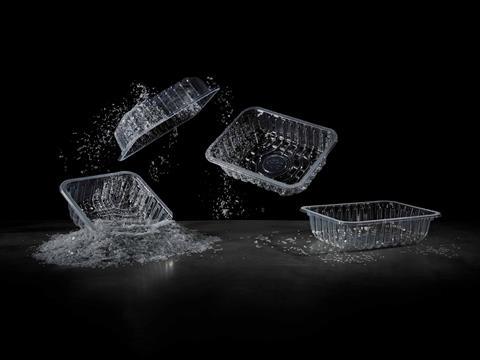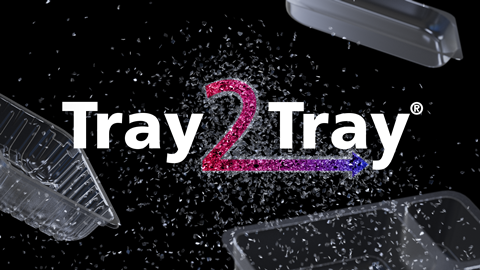In packaging, collective progress is often measured by how well we navigate challenges and seize opportunities. The recycling of PET (polyethylene terephthalate), a material central to our industry, perfectly illustrates this dynamic. Our effectiveness in addressing the complexities of PET recycling will undoubtedly shape the future landscape of sustainable packaging, says Samuel Pardo, Senior Innovation Manager at Klöckner Pentaplast.
As we stand at a critical juncture, it’s clear that despite PET’s well-known recyclability, we’re falling short of realizing its full circular potential – particularly when it comes to PET food packaging trays. This disconnect between the potential and the reality represents a significant challenge for our industry – one that we must address urgently if we’re to create a truly circular economy for all packaging.
The scale of our challenge is substantial. Each year, 750,000 tonnes of PET food trays are wasted. Once into the recycling loop, this material is often downcycled to other packaging applications, so the demand for virgin PET in food packaging trays is not slowing at the rate we’d hope. This figure represents not just a loss of valuable packaging material, but a missed opportunity to significantly reduce our industry’s environmental footprint. To address this, we need to develop and scale technologies that can efficiently process PET trays back into food-grade material, maintaining their highest value use.
So, how do we move these important conversations forwards? At Klöckner Pentaplast (kp), we’ve recognized that the path to circularity isn’t just about recycling – it’s about reimagining the entire lifecycle of our products. This perspective has driven our kp Tray2Tray® initiative, which aims to recover used food packaging trays and recycle them into new, food-safe packaging trays. By 2025, we aim for at least 30% recycled material in our packaging to originate from this programme, marking a significant step towards our goal of true circularity. We have also recently announced our very first food packaging trays made entirely from recovered kp Tray2Tray® flake. In short, the platform really is something to shout about.

Where the challenges lie – and how to address them
However, it’s important to acknowledge the complexities of the rPET market. Currently, a significant portion of rPET is directed towards bottle production, leading to potential scarcity in other applications. This situation has sparked debates within the industry about priority access to recycled materials. While some organisations argue that rPET capacity is sufficient to meet demand, the reality is that market dynamics and allocation of recycled materials remain challenging issues that our industry must navigate carefully. Individual company initiatives, while crucial, are not enough to drive industry-wide change.
The challenges we face in PET tray recycling are multifaceted and require a collaborative approach:
Collection and sorting infrastructure: To meet ambitious recycled content targets proposed by the PPWR (Packaging and Packaging Waste Regulation), we must dramatically improve collection rates and develop new streams for currently unrecycled materials.
Consumer education: Improving household and kerbside waste separation is crucial. There are strong calls for comprehensive campaigns that educate consumers about the importance of correct waste sorting and its impact on the recycling process.
Traceability and transparency: As we increase the use of rPET, ensuring the traceability of materials becomes paramount, especially for food-contact applications where we need absolute provenance in materials. To move forwards, the recycling industry must invest in robust traceability systems that can verify the origin and quality of recycled PET.
Harmonization of definitions: The industry faces challenges in establishing globally accepted standards for what constitutes ‘recycled content’. A unified framework is essential to streamline certification processes and build trust in recycled materials.
Standardization and Design For Recycling (D4R): The lack of unified standards across the EU hinders efficient recycling processes. We need to establish and enforce comprehensive D4R guidelines that ensure PET trays are designed with end-of-life considerations from the outset.

‘The path forward requires collaboration’
The incoming PPWR, Plastic Tax changes in the EU and UK, and the imminent Extended Producer Responsibility (EPR) regulations in the UK present multiple potential springboards for change. While they will bring much-needed harmonization to the food packaging market, meeting their ambitious recycling targets will require immediate and sustained effort from all stakeholders. However, we recognize that despite our laser-sharp focus in packaging sustainability, no single company can solve these challenges alone. The path forward requires collaboration across the value chain – from raw material suppliers and packaging manufacturers to brands, retailers, and recycling facilities. We need to foster an environment of open and honest dialogue, where best practices are shared, and new technologies are developed collectively.
As we look to the future, it’s clear that the role of PET and rPET in the circular economy will be defined by our ability to innovate, collaborate, and adapt. The challenges we face are significant, but so are the opportunities. By working together to close the loop on PET tray recycling, we can not only meet regulatory requirements but also set new standards for sustainability in the packaging industry.
The time for incremental change has passed. We need bold, decisive action to redefine PET’s role in the circular economy. Together, we can transform the challenge of PET tray recycling into a model of circular economy success.

This premium feature brings a completely new way for you to interact with our audience through a combination of collaborative editorial and premium promotion. An article written together between you and Packaging Europe’s content team, The Wider View will have a dedicated widget across all web pages & eNewsletter, and will link to a stunning, long-format web page put together by our design team featuring your graphics and branding. Carrying no other advertising, and pushing the limits of ordinary web communications, this is the ultimate digital content package.



















No comments yet